Submissions – Housing and Housing Finance Submission to the Inquiry into Affordable Housing
Senate Economics References Committee
- Download 1.3MB
This inquiry follows a sequence of prior inquiries into the affordability and accessibility of housing in Australia, including the Productivity Commission inquiry on First Home Ownership (Productivity Commission 2004) and the Senate Select Committee Inquiry on Housing Affordability in Australia (Senate 2008). The Reserve Bank provided input into both these inquiries (RBA 2003; Battellino 2008). The terms of reference of the present inquiry are broader than these earlier inquiries. This submission therefore focuses on selected parts of the terms of reference that relate to the Bank's responsibilities and are within the bounds of its expertise.
In addition to the two earlier submissions mentioned above and the references mentioned throughout this submission, staff at the Bank have produced a range of material that might be useful background to some of the issues raised in the terms of reference. Some references are provided in Appendix A.
Several key themes emerge from the Bank's analysis.
- At a macro level, pressures on affordability of both purchased and rental housing have eased somewhat since the previous Senate inquiry on this topic. The experience of specific groups in the population may, of course, differ.
- There is no shortage of housing finance in Australia. Mortgages are available at reasonable cost from a range of lenders, and households are not artificially constrained from borrowing as much as they can reasonably be expected to repay. Some of the (localised) examples of laxer lending standards seen in the years leading up to the global financial crisis have become less prevalent. This is a welcome development and should not be seen as an unwarranted constraint.
- Australian housing prices increased by about two-thirds relative to income in the decade or so up to around the end of 2003. This was primarily a secular shift resulting from disinflation and financial deregulation. Now that this transition is over, the rates of price growth and borrowing seen in that period should not be expected to re-occur, nor would it be desirable if they did.
- Whenever rising demand results in higher prices, the question arises of why supply cannot expand enough to prevent this. Australia faces a number of longstanding challenges in this area, including regulatory and zoning constraints, inherent geographical barriers and the cost structure of the building industry. There are also obstacles to affordable housing created by Australia's unusually low-density urban structure.
- Although the share of detached housing in Australia's housing stock is still high relative to that in other industrialised countries, the mix of housing is shifting to higher-density forms such as apartments and townhouses. This evolution to a more internationally typical housing mix has a number of potential benefits, including more efficient use of well-located land and a greater variety of housing options that can meet diverse needs. However, it also implies that construction costs could be higher, the time lag to project completion could be longer and the short-term responsiveness of supply could decline.
The remainder of this document provides some additional detail on recent developments in the housing market and the themes outlined above.
Developments since the 2008 Inquiry
Since the Senate Select Committee Inquiry reported in June 2008, several macroeconomic developments have helped improve measured affordability of housing in Australia.
- Variable mortgage interest rates are significantly lower, reducing the current required repayment on a typical new mortgage (Graph 1).
- Housing prices have risen broadly in line with, or a little slower than, household disposable incomes, with two episodes of flat to falling prices in most major cities being followed by cyclical upswings (Graph 2).
- Rental vacancy rates have risen somewhat, which has been consistent with an easing rate of growth in rents (Graph 3 and Graph 4). One possible contributor to this is the fact that population growth has eased a little from the rapid pace in 2008 and the preceding few years, although it remains very strong (Graph 5). Given that much of this earlier increase in population growth was driven by immigration on student visas (Graph 6), it was reasonable to expect the resulting increase in demand for housing to have been seen mainly in the rental markets in the major cities.
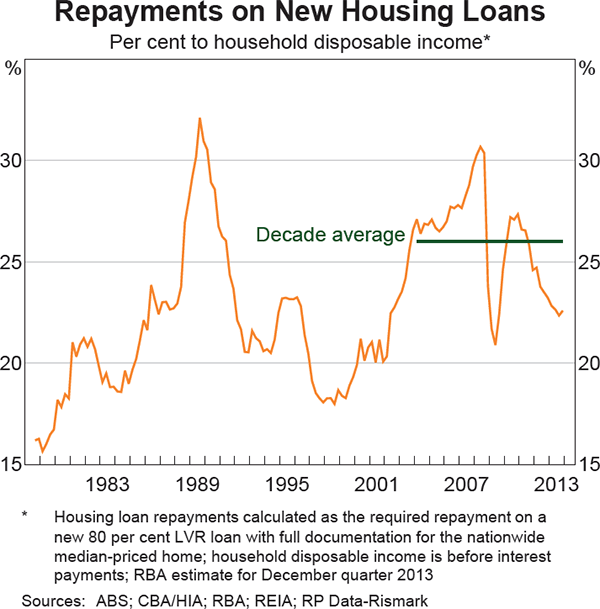
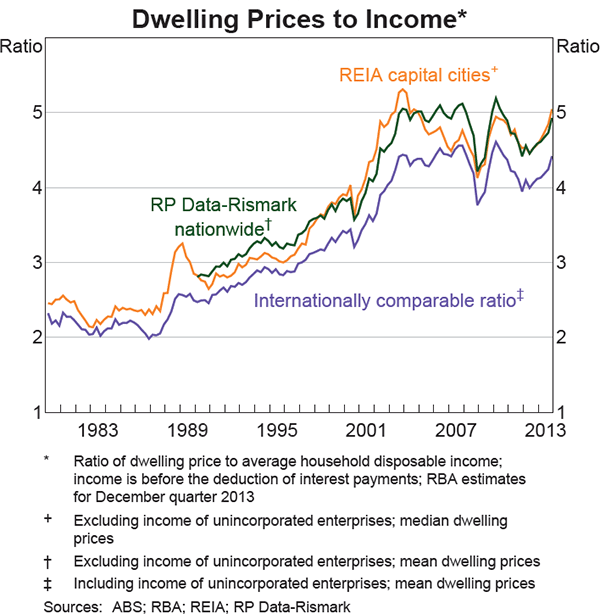
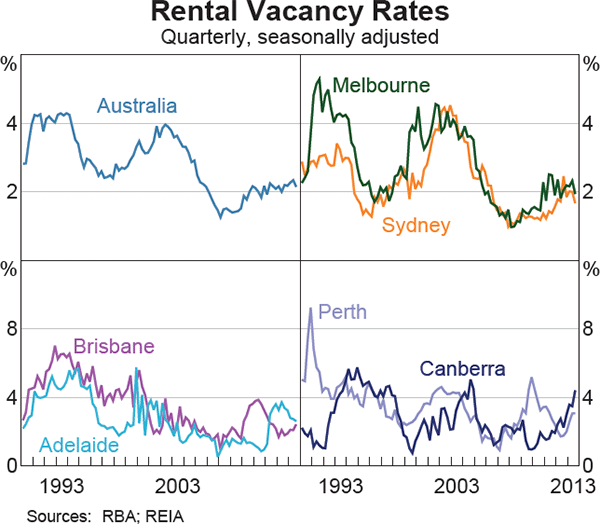
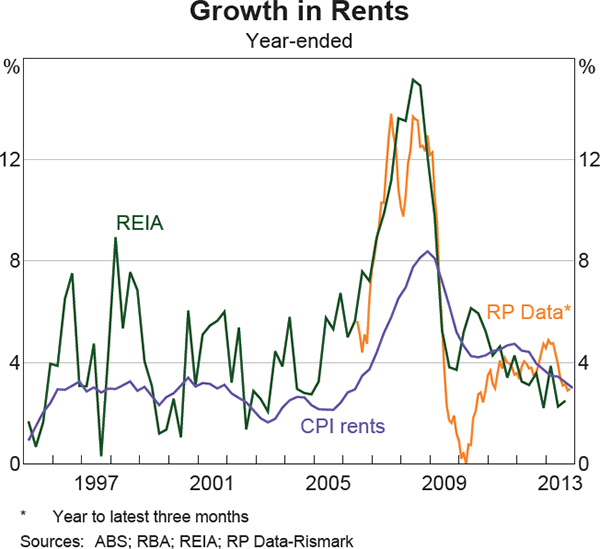
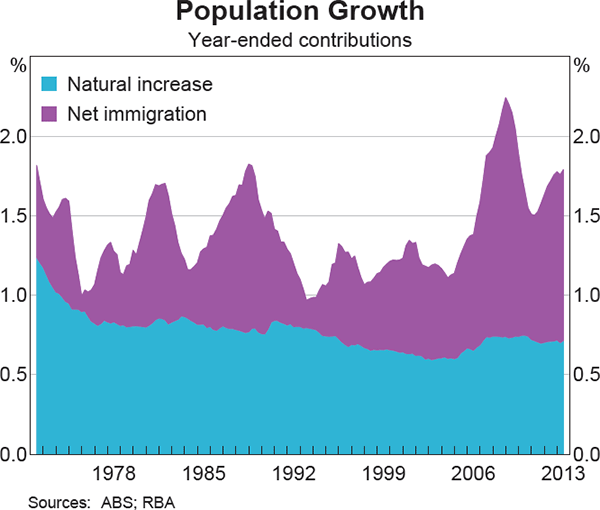
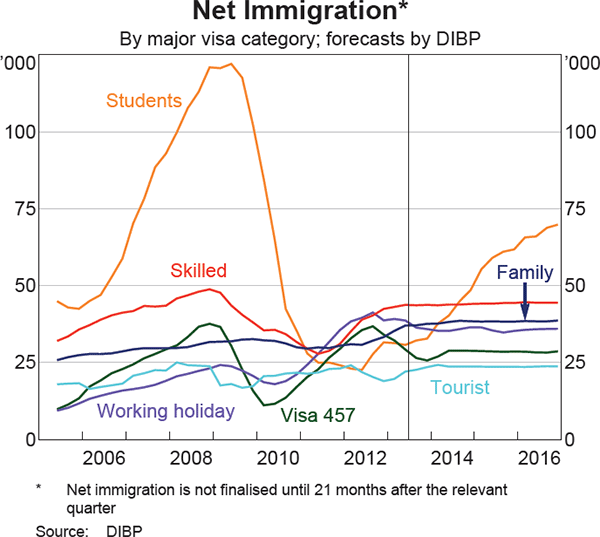
More recently, housing prices have risen in the capital cities, but have remained more stable in many regional areas (Graph 7 and Graph 8). The increase has been greatest in Sydney, where investor demand has of late been particularly strong. As discussed below, prudent limits on loan sizes are less binding for property investors with significant equity to deploy. It is therefore likely that this investor demand has contributed to the most recent run-up in prices in parts of Sydney. This development would have increased the supply of properties available for rent, but at the same time may have resulted in some potential home owners being priced out of parts of the market they might have otherwise been able to afford. Since this pick-up in investor demand has not involved a substantial increase in leverage, riskier loan types or entry of marginal borrowers, it does not yet pose significant risks to financial stability, but it bears close monitoring for signs of speculative excess.
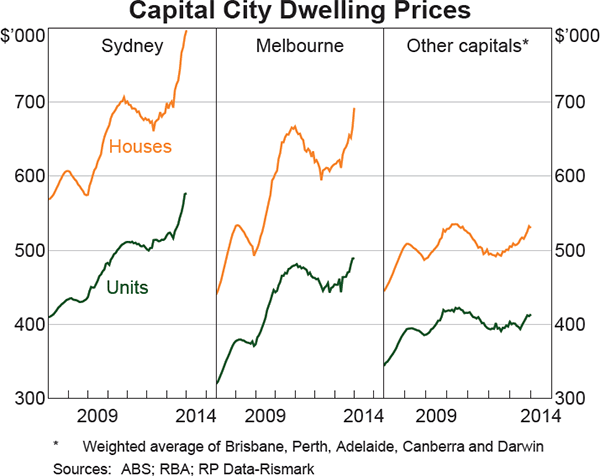
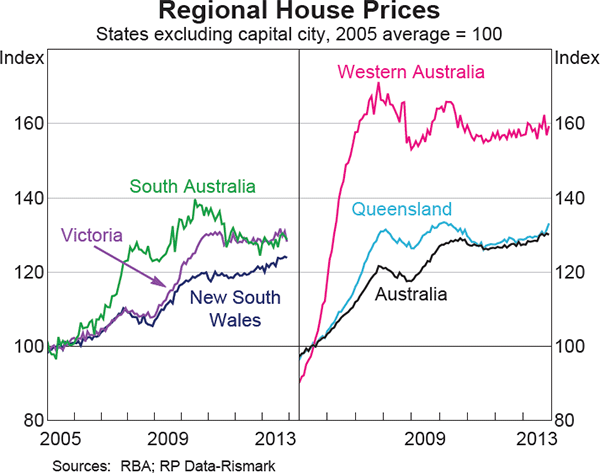
Access to Home Ownership
Accessibility of home ownership is not generally constrained by the availability of mortgage finance. Mortgage finance is available from a range of lenders. Although some lenders that had been reliant on funding from securitisation ceased or curtailed their lending business as a consequence of the crisis, this did not materially restrict the availability of housing credit. In any case, securitisation markets have begun to recover more recently (Aylmer 2013). Loan approvals for housing have picked up strongly as lower interest rates stimulated housing demand, and in dollar terms reached a new peak in late 2013, surpassing the earlier peak in 2007.
The spread between variable mortgage rates and the Reserve Bank's cash rate has widened since the crisis, but this is almost entirely attributable to the increase in lenders' funding costs relative to the cash rate and is similar to the increase for business rates; the Reserve Bank Board has accounted for this increase in funding costs in the setting of monetary policy (Graph 9). Although it is difficult to make international comparisons in this area, available data suggest that the spread between variable mortgage rates and the policy rate is similar to that in many other developed countries (Graph 10; see Stewart, Robertson and Heath (2013)).
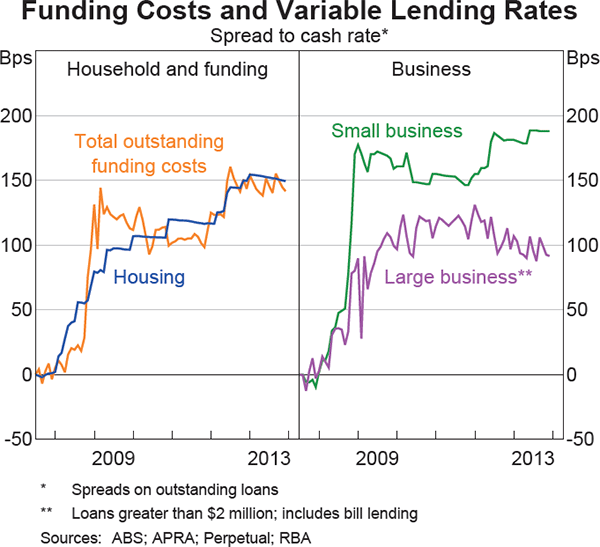
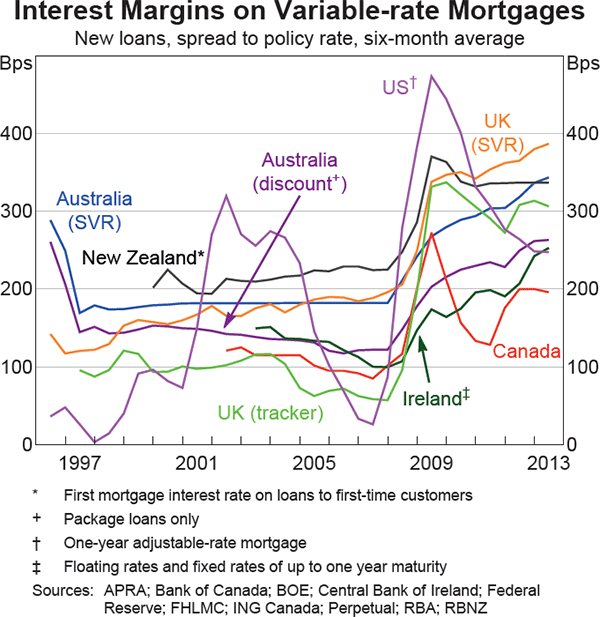
Home buyers are also not excessively constrained in their access to finance by the limits imposed by lenders to reflect the default risks that those borrowers pose. Lenders no longer base allowable loan amounts on simple ratios of repayments to income, as was standard practice in past decades. Therefore, borrowers are not constrained from devoting a larger percentage of their income to loan repayments if they can still maintain a comfortable living standard while doing so (APRA 2013). The borrowing limits that do exist are designed to reflect households' capacity to repay.
Over the cycle, however, these limits may have varying distributional effects. Typically the interest rate used to calculate allowable loan sizes does not fall as much as actual interest rates, or only up to a point. This means the marginal borrower has less scope to increase their loan size as interest rates fall. Consistent with this, average new loan sizes have not increased during the recent period of declining interest rates, even though the number of loans has (Graph 11). This practice is in the long-term interest of borrowers – it does not do a home buyer any favours to allow them to take out a loan that they cannot service once interest rates rise again. However, it does mean that borrowers for whom these constraints are not binding appear to have a relative advantage during periods of low interest rates, since they can actually increase their loan size and make larger offers for specific properties. Because, in the Australian environment, the most constrained borrower is usually a first home buyer and the less constrained borrowers are investors or trade-up buyers with considerable equity, this might help explain the low share of first home buyers in recent new lending for housing. Reductions in state government incentives for first home buyers (for established housing) would also have contributed to this outcome.
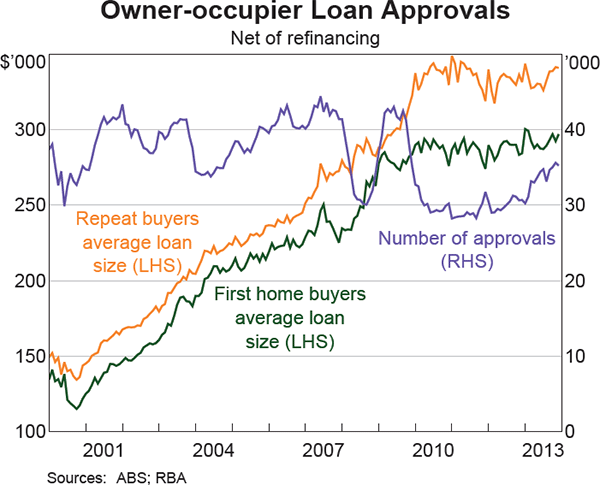
The experience of the United States in the lead-up to the financial crisis demonstrates that it is not in the long-term interest of either borrowers or lenders to boost ‘affordability’ by enabling households to borrow ever-larger amounts (Ellis 2010). Lending standards in the Australian mortgage market were not as loose as those seen in the United States in the years leading up to the crisis. There were, however, some instances of risky practices in Australia, which have become less prevalent in recent years. This is a welcome development and should not be seen as an unwarranted constraint (Graph 12; see RBA (2005), and APRA and RBA (2007)).
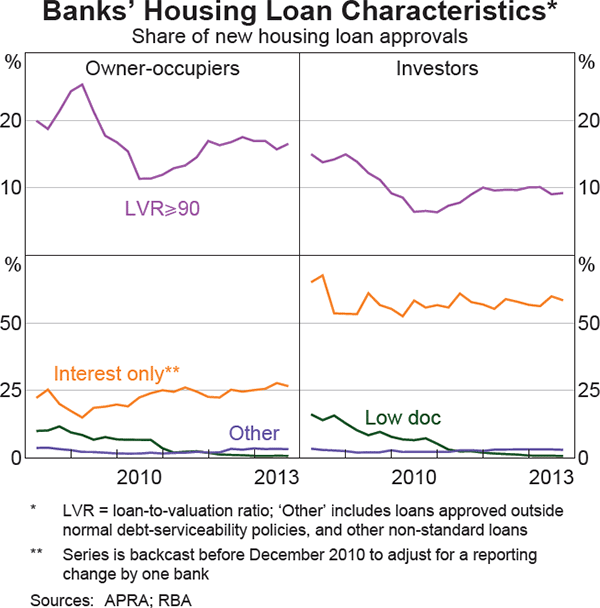
Available evidence suggests that financial stress among households with mortgages is not widespread. Although it will always be the case that some individual households find it difficult to meet their repayment obligations in the face of negative events (such as job loss, illness or relationship breakdown), there is no evidence of systematic provision of credit beyond the amount that borrowers can be reasonably expected to repay. Arrears rates are low and have fallen since their 2011 peak (Graph 13). Most personal bankruptcies are unrelated to mortgage debt, and they have also declined in recent years, as have home repossessions (Graph 14). Lenders have been willing to extend hardship relief to households that face temporary difficulties in repaying their loans, for example due to the floods in Queensland in late 2010 and early 2011. In addition, many households have built up buffers of excess repayments through offset and redraw facilities. These buffers provide those households with a cushion of prepayments that can be drawn down to avoid falling into arrears. By implication, these households' required mortgage repayments are affordable given their current financial circumstances.
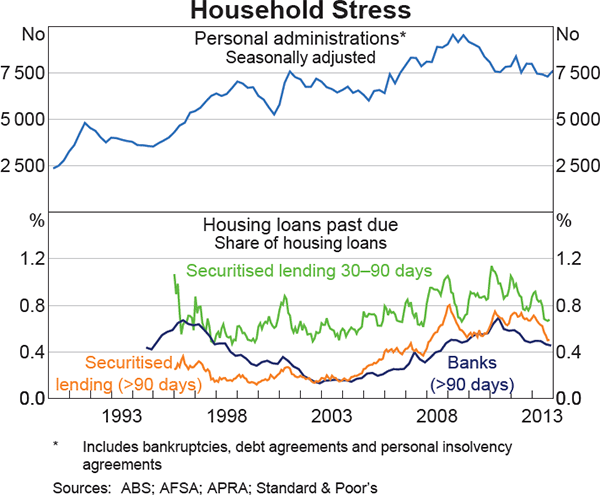

Long-term Determinants of Demand
The more recent developments described in the previous section are usefully seen in the context of the large increase in housing prices relative to the price of other goods and services and to household income that occurred over the 15 years or so to around 2003. There is no reason to expect housing prices to remain constant over the long term as other prices – and more particularly incomes – rise. Much of the strong increase in housing prices in dollar terms over the past couple of decades simply reflected Australia's relatively strong growth in household incomes. Housing prices have also increased relative to incomes since the 1980s, however (Graph 2 above; Yates 2011); similar shifts have occurred in a number of other countries. As the Bank has documented on previous occasions, the primary driver of this large increase in housing prices relative to income was the secular decline in average interest rates brought about by the decline in inflation in the 1990s, together with some increase in borrowing capacity enabled by financial deregulation (Graph 15; see Stevens (1997), Macfarlane (2003), Debelle (2004) and Ellis (2005), among others). Borrowers can service larger loans with the same repayment when average interest rates decline (Graph 16). Consequently the increase in loan sizes and housing prices attributable to this shift should not be construed as a decline in affordability. It may, however, have some implications for intergenerational equity if first home buyers increasingly rely on parental assistance or bequests to fund larger deposits (and thus higher prices) than they could sustain from their own resources, because such assistance may not be available to the children of renters.
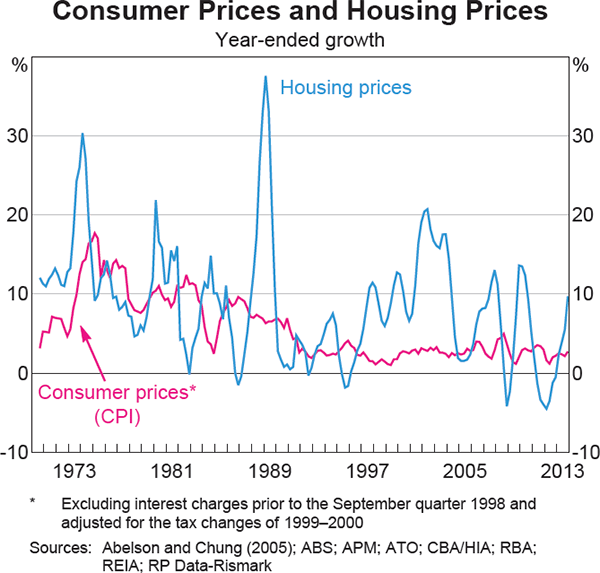
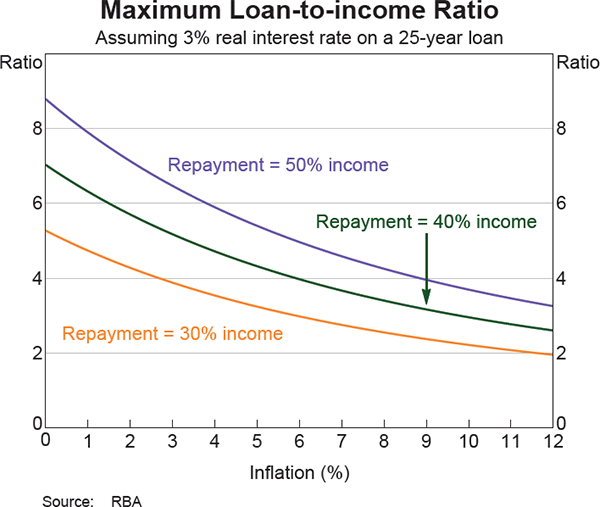
The available data suggest that the transition to the new equilibrium of lower inflation and interest rates, and thus higher debt and housing prices, was completed by around 2005. Since then, housing price growth has cycled around a lower average and similarly housing credit growth has been slower than in previous decades.
The completion of this transition has a number of implications for current and future outcomes. In particular, if price rises are cycling around a lower average rate, then as a matter of arithmetic, falls in nominal prices are likely to be more common than in earlier decades. Because periods of price falls make development of new homes unattractive, this shift may also have the result that supply is weaker in downturns than was the case in the past, and takes longer to pick up. In addition, since housing loans are expressed in dollar amounts and not indexed to consumer or housing prices, this implies that it could become more common for the outstanding loan amount to exceed the current value of the individual property. Such a ‘negative equity’ situation is more difficult for households if they do face payment difficulty, because they cannot resolve the situation by selling the property (Ellis 2008). It also increases losses to the lender if the borrowing household does default on the loan. Lenders need to allow for this potential for increased risk in their lending decisions. This implies that the tightening in some aspects of mortgage lending standards, such as the reduced provision of low-doc loans and tighter ‘genuine savings’ requirements for deposits, has been a welcome recalibration of industry practice.
Urban Structure and Supply
Any increase in demand for a good or service will be met with some combination of an increase in prices and an expansion in quantity supplied. It is unrealistic to expect prices to be completely unaffected as demand increases. In the housing market, the price responses seem to dominate the quantity supply responses, which can have undesirable consequences. A period of rapidly rising prices does not only make it harder for first home buyers to purchase a home; if the price growth is extrapolated into expectations about the future, it can engender a speculative boom that, with its attendant increase in leverage, could be harmful to financial stability.
Housing supply is often constrained by various regulations – for example on land use, allowable heights and densities, and permissible building types and materials. Some of the planning and approval processes involved in housing construction create delays that also add to costs (Hsieh, Norman and Orsmond 2012). These issues are not specific to Australia and many of these regulations are intended to promote other social goals, such as ensuring buildings are constructed safely and that neighbouring residents do not have costs and inconveniences imposed upon them about which they are not consulted. Even if these restrictions and delays did not exist, however, housing supply is inherently sluggish. Demand for housing is demand for a housing stock – or strictly speaking, for the flow of housing services provided by that stock. The flow of new construction is small relative to the stock, so it is difficult to adjust the stock quickly in response to fluctuations in demand. Identifying suitable sites for development and completing the construction phase take time (even without regulatory delays), so there is also an inherent sluggishness to that flow of new construction. The cost of constructing that new supply will also rise more rapidly if suitable sites are limited by geographical features such as coasts, national parks and steeply sloping areas. Housing supply responses in Australia might therefore be constrained in part by the fact that a large percentage of the population lives in coastal cities where expansion cannot occur in every direction.
Australia also faces particular structural constraints in its capacity to provide new housing at a reasonable cost because of its population structure. The urban population is unusually concentrated in two large cities, and these and the other large cities have unusually low population densities compared with cities in other developed countries with similar populations sizes (Graph 17 and Graph 18). It is more costly to build additional housing supply in a limited number of locations; land prices could be expected to be lower if there are more undeveloped locations competing for buyers. In addition, past theoretical and empirical work suggests that cities with larger populations have more expensive housing, even relative to their generally higher incomes, than smaller cities and towns (Gabaix 1999; Kohler and Smith 2005). The primary reason for this effect is that larger cities offer more diverse job opportunities as well as the cultural and social amenities that become feasible at scale. That everybody does not move to the one place implies that there must be disadvantages balancing out these advantages; these include congestion and perhaps crime, but, importantly, also higher housing costs relative to income.
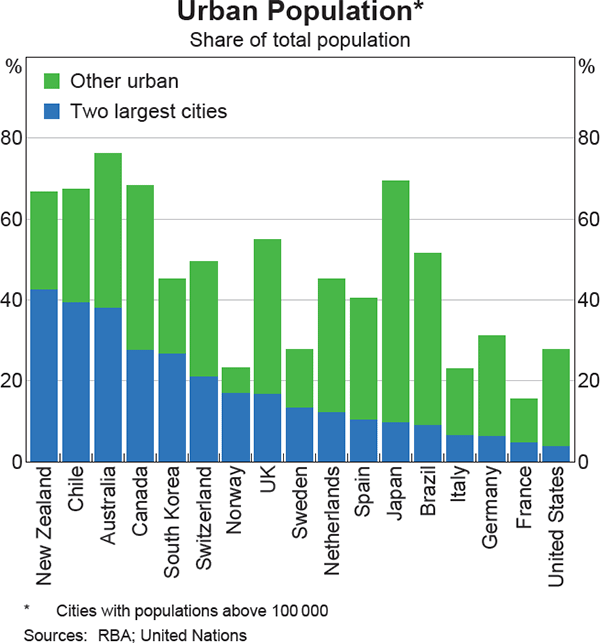
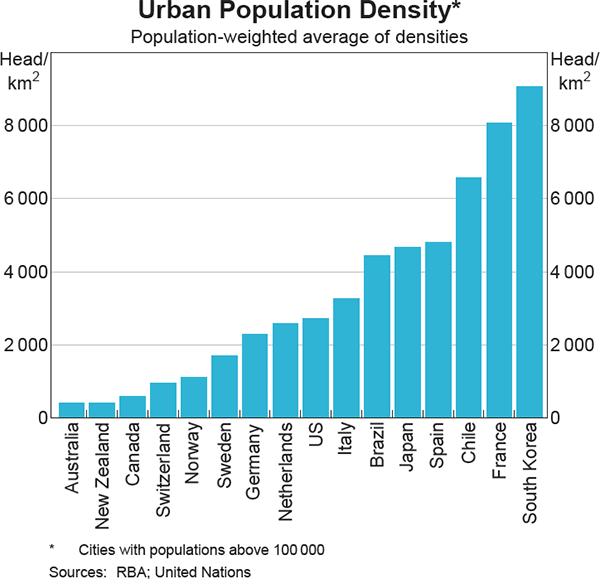
Unlike many other comparable countries, Australia lacks the medium-sized cities (500,000–1,000,000 inhabitants) that could provide alternatives to households seeking to avoid high housing costs in the largest cities, while still offering the range of job opportunities that cannot be supported in smaller towns. As a simple matter of aggregation, a country like Australia that has much of its population in large, higher-cost cities might have a higher national figure for metrics such as the ratio of housing prices to incomes, even if these ratios are not so different when comparing across cities of comparable populations in different countries (Andrews 2001); in any case, Australia's ratio is not outside the range of other countries' experience (Fox and Finlay 2012). There are probably many reasons for this concentration, including the historical fact of Australia's relatively early urbanisation, large distances and a federal political system (Ades and Glaeser 1995).
The low urban density is in part a legacy of many past decisions, including postwar policies to promote construction of detached houses on suburban land blocks. A corollary of this low-density structure is that an unusually high share of the housing stock is in the form of detached houses, particularly single-storey structures (Ellis and Andrews 2001). It is also likely to imply higher housing costs and prices than in other developed countries, on top of the previously mentioned effect of the concentration in large cities.
The preceding discussion implies that, while there are no doubt regulatory changes that can be made that would reduce the costs and time involved in housing construction projects, it is questionable whether this would reduce prices by enough to bring home purchase within reach of many additional households. In many cases, the bulk of the cost of a new dwelling is the cost of construction, not the government charges or land, though construction costs might be lower if some building regulations were changed (Graph 19). Extra supply can dampen price growth, and has probably done so in recent years in Melbourne and parts of Queensland. However, if there are no suitable properties within some households' capacity to pay, prices would need to be significantly lower to match those households' current budgets. History shows that this would be difficult to achieve without also constraining demand – that is to say, buyers' capacity to pay. Such an outcome could not be described as an improvement in affordability.

Over the past couple of decades, and especially over the past few years, the composition of new housing construction has shifted towards apartments (Graph 20). More than 40 per cent of new residential building approvals are currently for medium-density or higher-density housing; this compares with around one-quarter in the 1970s and 1980s. Because the flow of new construction is inherently much smaller than the stock, the effect of this on the composition of the housing stock is more muted, but there has been a clear trend towards an increased share of higher-density housing. This shift has started to bring the composition of Australia's dwelling stock more in line with that in other developed countries, offering a wider range of housing types to satisfy diverse needs. In particular, denser construction allows households to choose to economise on the amount of land they consume, rather than being restricted to larger (and more expensive) blocks and detached structures. On the other hand, construction lags are longer and per-dwelling construction costs are inherently higher for multistorey construction (Graph 19).
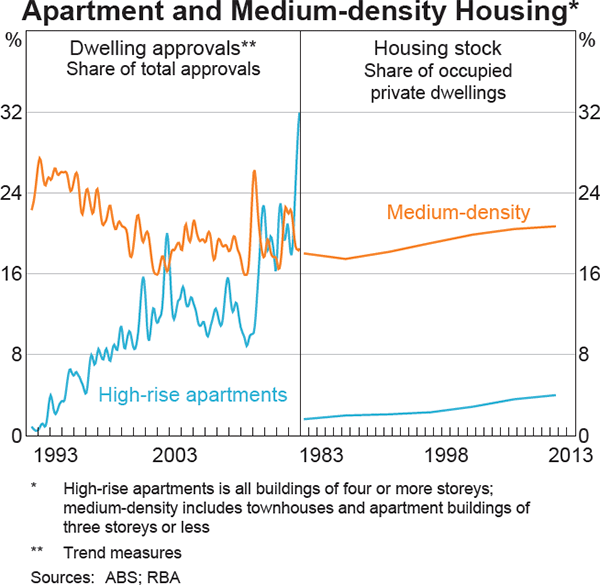
Appendix A
Battelino R (2009), ‘Housing and the Economy’, Remarks to the 6th National Housing Conference, Melbourne, 25 November.
Berger-Thomson L and L Ellis (2004), ‘Housing Construction Cycles and Interest Rates’, RBA Research Discussion Paper No 2004-08.
Bloxham P and C Kent (2009), ‘Household Indebtedness’, Australian Economic Review, 42(3) pp 327–339.
Bloxham P, C Kent and M Robson (2010), ‘Asset Prices, Credit Growth, Monetary and Other Policies: An Australian Case Study’, RBA Research Discussion Paper No 2010-06.
Ellis L (2006), ‘Housing and Housing Finance: The View from Australia and Beyond’, RBA Research Discussion Paper No 2006-12.
Ellis L (2010), ‘Recent Developments in the Housing Market and its Financing’, Speech at the Financial Review Residential Property Conference, Sydney, 18 May.
Ellis L (2011), ‘Eight Policy Lessons from the US Housing Meltdown’, Housing Studies, 26(7–8), pp 1215–1230.
Ellis L (2012), ‘Prudent Mortgage Lending Standards Help Ensure Financial Stability’, Address to the Australian Mortgage Conference 2012, Sydney, 23 February.
Ellis L, S Black and LD Smith (2005), ‘Housing Finance in Australia’, CGFS Publications No 26. Available at <http://www.bis.org/publ/wgpapers/cgfs26ellis.pdf>.
Ellis L, M Kulish and S Wallace (2012), ‘Property Market Cycles as Paths to Financial Distress’, in A Heath, F Packer and C Windsor (eds), Property Markets and Financial Stability, Proceedings of a Conference, Bank for International Settlements and Reserve Bank of Australia, Sydney, pp 109–132.
Ellis L, J Lawson and L Roberts-Thomson (2003), ‘Housing Leverage in Australia’, RBA Research Discussion Paper No 2003-09.
Finlay R (2012), ‘The Distribution of Household Wealth in Australia: Evidence from the 2010 HILDA Survey’, RBA Bulletin, March, pp 19–27.
Kent C (2013), ‘Recent Developments in the Australian Housing Market’, Address to the Australian Institute of Building, Sydney, 14 March.
Kent C, C Ossolinski and L Willard (2007), ‘The Rise of Household Indebtedness’, in C Kent and J Lawson (eds), The Structure and Resilience of the Financial System, Proceedings of a Conference, Reserve Bank of Australia, Sydney, pp 123–163.
Kohler M and A Rossiter (2005), ‘Property Owners in Australia: A Snapshot’, RBA Research Discussion Paper No 2005-03.
Kulish M, A Richards and C Gillitzer (2011), ‘Urban Structure and Housing Prices: Some Evidence from Australian Cities’, RBA Research Discussion Paper No 2011-03.
RBA (Reserve Bank of Australia) (2002a), ‘Innovations in the Provision of Finance for Investor Housing’, RBA Bulletin, December, pp 1–5.
RBA (2002b), ‘Recent Developments in Housing: Prices, Finance and Investor Attitudes’, RBA Bulletin, July, pp 1–6.
RBA (2003), ‘Household Debt: What the Data Show’, RBA Bulletin, March, pp 1–11.
RBA (2006), ‘Box B: Interest-only Housing Loans’, Financial Stability Review, September, pp 42–43.
RBA (2009), ‘Box B: Measurement of Housing Arrears’, Financial Stability Review, September, pp 55–57.
RBA (2012), ‘Box B: Home Mortgage Debt: Recent Insights from the HILDA Survey’, Financial Stability Review, March, pp 53–56.
Richards A (2008), ‘Some Observations on the Cost of Housing in Australia’, Address to 2008 Economic and Social Outlook Conference, The Melbourne Institute, Melbourne, 27 March.
Richards A (2009), ‘Housing Market Developments’, Speech at the CEDA Housing Forum: A National Round-up, Sydney, 29 September.
Schwartz C, T Hampton, C Lewis and D Norman (2006), ‘A Survey of Housing Equity Withdrawal and Injection in Australia’, RBA Research Discussion Paper No 2006-08.
Stevens GR (2012), ‘The Lucky Country’, RBA Bulletin, September, pp 75– 83.
Windsor C, J Jääskelä and R Finlay (2013), ‘Home Prices and Household Spending’, RBA Research Discussion Paper No 2013-04.
References
Abelson P and D Chung (2005), ‘The Real Story of Housing Prices in Australia from 1970 to 2003’, Australian Economic Review, 38(3), pp 265–281.
Ades AF and EL Glaeser (1995), ‘Trade and Circuses: Explaining Urban Giants’, Quarterly Journal of Economics, 110(1), pp 195–227.
Andrews D (2001), ‘City Sizes, House Prices and Wealth’, RBA Bulletin, December, pp 1–6.
APRA (Australian Prudential Regulation Authority) (2013), ‘Loan Serviceability Standards in Housing Lending’, APRA Insight, Issue 2. Available at <http://www.apra.gov.au/Insight/Documents/Insight%20Issue%202%202013_Web.pdf>.
APRA and RBA (Reserve Bank of Australia) (2007), ‘Joint RBA-APRA Submission to the Inquiry into Home Lending Practices and Processes’, August.
Aylmer C (2013), ‘Developments in Secured Issuance and RBA Reporting Initiatives’, Address to the Australian Securitisation Forum, Sydney, 11 November.
Battellino R (2008), ‘Background Notes for Opening Remarks to the Senate Select Committee on Housing Affordability in Australia’, 24 April.
Debelle G (2004), ‘Macroeconomic Implications of Rising Household Debt’, BIS Working Papers No 153.
Ellis L (2005), ‘Disinflation and the Dynamics of Mortgage Debt’, in Investigating the Relationship between the Financial and Real Economy, BIS Papers No 22, Bank for International Settlements, Basel, pp 5–20 .
Ellis L (2008), ‘How Many in Negative Equity? The Role of Mortgage Contract Characteristics’, BIS Quarterly Review, December, pp 81–93.
Ellis L (2010), ‘The Housing Meltdown: Why did it Happen in the United States?’, International Real Estate Review, 13(3), pp 351–394.
Ellis L and D Andrews (2001), ‘City Sizes, Housing Costs, and Wealth’, RBA Research Discussion Paper No 2001-08.
Fox R and R Finlay (2012), ‘Dwelling Prices and Household Income’, RBA Bulletin, December, pp 13–22.
Gabaix X (1999), ‘Zipf's Law for Cities: An Explanation’, Quarterly Journal of Economics, 114(3), pp 739–767.
Hsieh W, D Norman and D Orsmond (2012), ‘Supply-side Issues in the Housing Sector’, RBA Bulletin, September, pp 11–19.
Kohler M and K Smith (2005), ‘Housing and the Household Wealth Portfolio: The Role of Location’, RBA Research Discussion Paper No 2005-10.
Macfarlane IJ (2003), ‘Do Australian Households Borrow Too Much?’, RBA Bulletin, April, pp 7–16.
Productivity Commission (2004), First Home Ownership, Productivity Commission Inquiry Report No 28, Melbourne.
RBA (Reserve Bank of Australia) (2003), ‘Submission to the Productivity Commission Inquiry on First Home Ownership in Australia’, RBA Occasional Paper No 16.
RBA (2005), ‘Box B: Developments in the Low-doc Loan Market’, Financial Stability Review, September, pp 39–40.
Senate Select Committee on Housing Affordability in Australia (2008), A Good House is Hard to Find: Housing Affordability in Australia, SCHAA, Canberra. Available at <http://www.aph.gov.au/Parliamentary_Business/Committees/Senate/Former_Committees/hsaf/report/index>.
Stevens GR (1997), ‘Some Observations on Low Inflation and Household Finances’, RBA Bulletin, October, pp 38–47.
Stewart C, B Robinson and A Heath (2013), ‘Trends in the Funding and Lending Behaviour of Australian Banks’, RBA Research Discussion Paper No 2013-15.
Urbis (2011), ‘National Dwelling Cost Study’, Prepared for the National Housing Supply Council, May.
Yates J (2011), ‘Housing in Australia in the 2000s: On the Agenda Too Late?’, in H Gerard and J Kearns (eds), The Australian Economy in the 2000s, Proceedings of a Conference, Reserve Bank of Australia, Sydney, pp 261–296.
Acknowledgement
The graphs in this publication were generated using Mathematica.